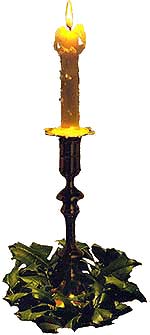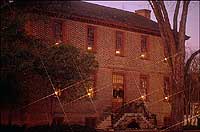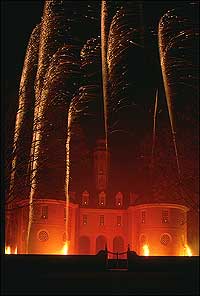Page content
Candles in the Windows
Since the first organized Christmas celebration drew visitors to Colonial Williamsburg in 1936, nothing quite matches the excitement, sights, smells, sounds, and grandeur of the Christmas Season in Colonial Williamsburg's Historic Area. But how did the celebration evolve?

No one really expected anyone to visit newly restored Colonial Williamsburg during the holidays in 1934, but colored lights were strung on ten evergreen trees in the Historic Area. Foundation president Kenneth Chorley was not very pleased with the effort and directed the research department to find authentic historical practices that could be revived.
The historians came up empty, as Christmas was not much of a holiday in colonial America. Most Virginians were members of the Anglican Church, and as such, observed the season of Advent, a time of fasting and repentance, followed by a celebratory meal Christmas Day. Letters and diaries refer to church services and a nice meal. Servants were sometimes given a half day off and a coin. Discouraged but not daunted, Chorley was determined to find a festive way to celebrate the season.
Landscape architect Arthur Shurcliff recalled a practice his family had begun in Boston in 1893 and suggested placing a single lighted candle in the windows of the four buildings open to the public in those days. The candles were lit from 5:00 p.m. to 10:00 p.m. between Christmas Eve and New Year's Eve. Louise Fisher, who was in charge of flowers, decorated the doors and windows of the Palace and the Raleigh Tavern with simple fresh greenery.

Nervous about fire, Dr. W.A.R. Goodwin, rector of Bruton Parish Church, insisted the candles be placed in a dish of water. Four janitors were paid $1.00 apiece to light the candles and guard against fires. With the availability of electric candles, the practice gained in popularity throughout the community, to the point that visitors to Colonial Williamsburg wanted to purchase the candles to take back to their own communities. In 1941, local department stores sold their entire stock of 600 electric candles by Christmas Eve. Today, the practice has spread all across America and is attributed to Colonial Williamsburg, even though the Foundation made it clear it was not a historically accurate holiday practice.

Fireworks were a popular 18th-century attraction fired in honor of a monarch's birthday or a great victory. In 1957, as part of the celebration for the 350th anniversary of the founding of Jamestown, Colonial Williamsburg set off fireworks on Market Square. From then on, fireworks have been an integral part of the Colonial Williamsburg Christmas experience.
Today, fireworks, candles, cressets, and small street fires are all a part of the Christmas season in Colonial Williamsburg's Historic Area, which officially begins with Grand Illumination the first Sunday in December. The “simple fresh greenery” has evolved into elaborate decorations hand-made from fresh fruits, vegetables, and evergreens adorning doors, windows, fences, lampposts, and transoms. Far from a time of repentance, the month of December is full of fine food, music, laughter, and a true sense of magic. It may not be the way the holiday was celebrated in colonial America, but the Christmas season in Williamsburg has evolved into a tradition recognized all across America.
Come experience the magic for yourself and give your family a holiday they will never forget.
Information for this story came from “Lighting the Town, Birth of a holiday tradition in Colonial Williamsburg” by Libbey H. Oliver and Mary Miley Theobald, autumn 1995 journal “Colonial Williamsburg.”
Read more articles from the Foundation's journal, “Colonial Williamsburg”.
